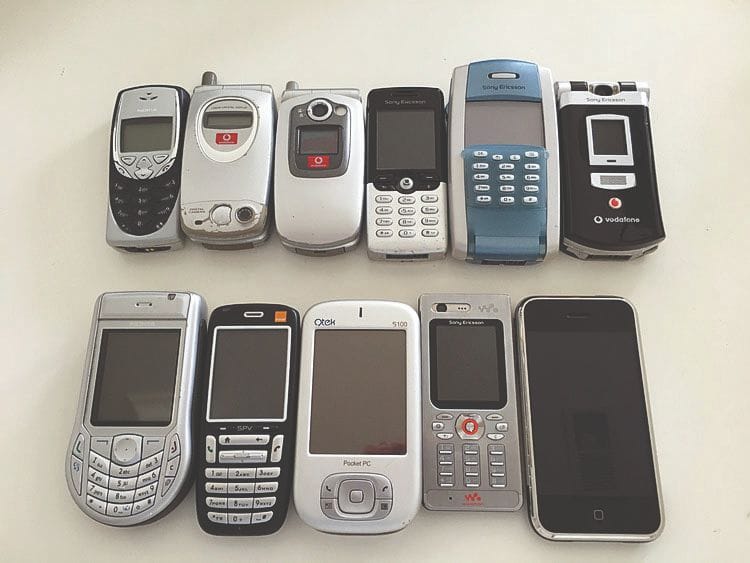The Form Factor of Modern Smartphones
Revolutionary Shifts in Modern Smartphone Design

Smartphones, and mobile phones in general, are nothing but merely an extension of the human mind; to put it simply, these devices serve as external information banks and keep us connected with the outside world. Always adapting and evolving to meet the needs of the consumer, the form-factor (i.e. the design) of these devices have seen numerous variations and changes over the past three decades. From the brick to flip-phones, early day mobile handsets serve as the ancestors of the modern-day smartphone. Their past plays a big role in where their future is headed. Despite being nearly thirty years apart, these devices share a common purpose: to serve its user as a basic communication device. To be fair, neither of these devices, albeit modern or retro, fall short on that end.
Modern smartphones take it a step further, with video call, internet voice call, instant messaging, social media, video streaming, etc. The reason why today’s phones have a much more multi-purpose nature is because they’re very personal devices. Nobody would want to carry one different device for each purpose; it just isn’t practical in a fast moving world where things have to be seamlessly connected.
Coming back to retro phone design, it’s evident that there was quite a large variety. The design of the phone acted as identifiers of the company they represented; each phone possessed unique quirks and features that signaled the brand. An iconic example is a standard Blackberry handset. Immediately recognizable, this device stood out from the rest with its square-shaped, palm-sized design with a full-size physical keypad.
Companies saw selling phones to consumers as a great profit-making opportunity and started pushing out phones at a rate higher than the demand. It was inevitable that mobile handsets were the most effective way to stay connected with others, and soon enough, widespread adoption on a global scale took place. In effect, it was a matter of competition between smartphone vendors to produce phones that attracted consumers. With this trend came handsets that lacked the ease-of-use factor and had way too many unnecessary features; to put it simply, they weren’t centered around the user. Rather, these devices were aimed at increasing their brand’s share of the market and the profits that came with it.
Ever remember the day when you had to press a key multiple times for a letter to show up? Well, that’s exactly how it was in retro mobile handsets with the exception of those that possessed a full keypad. With physical keypads and buttons, these devices didn’t have a large screen real estate. As a matter of fact, their physical footprint wasn’t nearly as large as today’s smartphones, well, with the exception of the retro brick cell phone.
Due to their minimum functionality, the structure tended to be more versatile and thus came in many forms, one of the most iconic being the capability to “flip”. Composed of two parts connected by a hinge mechanism, this design saw the phone being split distinctly into two parts: the keypad and the display. This method allowed for much larger displays while maintaining the same footprint while folded, albeit a bit thicker.
Again, keep in mind that phones of this time were mostly used for calling, texting, e-mail, memos, and playing very simple games. Later, the camera and music player were integrated into the phone. This critical step essentially reduced the need to carry two extra devices.

Another key factor is that almost all the software on the phone was developed by the company that produced it. There were little to none third party software programs and the idea of an app store was still a concept. In effect, the past saw the usage of “smartphones” in a much primitive way.
Over the past two decades, the functionality and ease-of-use of phones have grown exponentially, thus making them “smart”. This key attribute also includes the nature of the device to link up with the internet. Third party support has been more than ever and the implementation of an app store provides the device with an ever-increasing set of features to keep the user engaged.
Today’s smartphone line-up are based on two primary platforms: Android and iOS. In the past, companies created their own proprietary OSs and frameworks. This is primarily what lead to the lack of third-party support.
Now, imagine today’s world except that each brand had their own proprietary OS, well, apart from Apple. Also, keep in mind that most third-party support either comes from small startups or the open source community.
These groups don’t have the time to adapt their solutions to every platform at the rate of demand. In addition, this mess only truly shows itself when you comprehend the manpower required to develop apps for each operating system. In the case of startups, it’s impractical as their goal is to reach widespread adoption while maintaining spendings under the budget.
On the flip-side, since most modern smartphones operate on either of the two platforms, any hardware change or addition would require a ton of work in the software end by the smartphone manufacturer to update their framework to allow for the maintenance of third party support. This is a very tedious job and doesn’t motivate radical design changes; that is, it’s hard to adapt the software to changes in hardware. To put it simply, it just isn’t financially practical.
Even with these widespread platforms, the core functionality of the devices are most highlighted by their app stores. In the world of Android, Google leads the industry with its play store and Google services, without which most companies wouldn’t survive.
Anyways, going back to the design of smartphones, it’s now clear that the stagnation in variety of design is primarily due to software limitations. However, companies are now looking past this limitation to push out smartphones that make their brand look unique in the face of consumers. The standard rectangular glass and metal slab design that started with the original iPhone is now slowly fading with smartphone manufacturers taking inspiration from past designs and applying it to the modern scenario. A more recent example of this is the Samsung Galaxy Fold — A flip-phone inspired smartphone with a radical modern twist.
With smartphones looking more alike than ever with all screen displays, smartphone vendors are pouring money into innovation to keep their brand name from hanging on the balance. In this process, we consumers gain access to devices that both meet our needs as well as the needs of the manufacturers.
The “rectangular-slab” design was so influential that manufacturers found it convenient to stick with it and go on from there with their variants. However, the variables (screen size, frame, camera layout, speaker placement, etc.) they can control are limited and it’s only a matter of time before brands start to lose their identity. In other words, there’s only so much you can do with that space.
There have been quite a few companies that have tried to resolve this issue over the past year while promising to maintain software support:
• Samsung Galaxy Fold with an inner foldable OLED display and a secondary screen on the front of the device.
• Huawei Mate X with a foldable OLED display that folds outwards as opposed to inward fold in the Galaxy Fold.
• Xiaomi Mi Mix 3 Alpha with a display that wraps around the edge and extends all the way to the back of the phone.
• Microsoft Surface Duo, a dual display device aimed at productivity and multitasking.
Apart from these revolutionary examples, these have been phones that take different, more cost-effective approaches to uniqueness. The most simple of these approaches being the layout and arrangement of the camera system. The front camera has recently seen a tremendous amount of change over the past two years. With the different variations of the “notch” to cameras that “pop-up” from the outer casing of the device, smartphone manufacturers are truly pushing, what I like to call, silent innovation. This kind of innovation serves, as previously said, to make the most out of the space in a smartphone.
Examples of this “silent innovation” include:
- Bending of the OLED screen under the phone’s metal housing to eliminate the “chin”. (iPhone X series and above)
- Curving the display towards the side-edges to cause an illusion that eliminates the presence of a side bezel. (Most notable: Oppo’s “Waterfall” display prototype)
- Google Pixel 4’s motion sense, which uses a Soli radar sensor to detect hand gestures.
- Facial mapping and recognition as a security measure to unlock the device. (Apple’s FaceID and Google’s Face Unlock)
- Depth mapping and advanced image processing using multiple cameras.
- Pressure sensitive displays and Taptic engines to detect and simulate depth while force-pressing on the screen. (Apple’s 3D Touch)
- Precision cutting a whole in a display to house the front-facing camera module. (Flagship Samsung phones such as S10 & Note 10 series)
With more advanced, innovative solutions such as under-display cameras and port-less, water-proof phones, it’s only a matter of time before we witness the next revolutionary, industry-standard form-factor for smartphones of our future.







